Find more information in the General Comments section of the assessment
Find more information in the Rating Validity tab of the assessment
- See More
- See More
- See More
- See More
- Good
- Adequate
- Marginal
- Weak
- Poor
 Passenger
Passenger
 Driver
Driver
 Front Seat
Front Seat
 Car
Car
 Pole
Pole
- Good
- Adequate
- Marginal
- Weak
- Poor


Passenger
outboard
center
Fitted to the vehicle as standard
Not fitted to the test vehicle but available as option
Not Available
In the frontal test, forward movement of the 3 year dummy, sat in a forward facing restraint, was not excessive. In the side impact, both dummies were properly contained within the shells of their restraints, minmising the likelihood of dangerous head contacts. . The passenger airbag can be disabled for Mercedes Benz child restraints if the car is equipped with an optional, automatic-detect system known as CPOD. The system does not meet Euro NCAP's requirements and was not rewarded. The passenger airbag can also be disabled by Mercedes Benz dealers, allowing a rearward facing child restraint to be used in that seating position. Clear information was displayed in the car regarding the dangers of using a rearward facing restraint in that seating position without first disabling the airbag.
- Good
- Adequate
- Marginal
- Weak
- Poor

Head Impact 14.6 Pts
Pelvis Impact 0.0 Pts
Leg Impact 6.0 Pts
The bumper scored maximum points for its protection of pedestrians' legs. However, the front edge of the bonnet provided predominantly poor protection. The C Class Coupe has an active bonnet. Sensors detect when a pedestrian has been struck and actuators raise the bonnet to provide greater clearance to hard structures beneath. Mercedes Benz showed that the system would detect a range of pedestrian statures and would work over a broad range of speeds, so the bonnet was tested in the raised position. In most areas likely to be struck by a child's head, the bonnet provided good protection. An adult's head might strike on the bonnet surface, where the car offered good protection, or on the windscreen, where protection was poor.
- Good
- Adequate
- Marginal
- Weak
- Poor
| Performance | ||
| Vehicle Yaw Rate @ COS + 1.00 s | 5.098% | meets ECE requirements |
| Vehicle Yaw Rate @ COS + 1.75 s | 1.451% | meets ECE requirements |
| Lateral Displacement @ BOS + 1.07 s | 1.25 m | meets ECE requirements |
| Applies To | All seats | ||
| Warning | Driver Seat | Front Passenger(s) | Rear Passenger(s) |
| Visual | |||
| Audible | |||
|
|||
Electronic stability control is standard equipment on all C Class Coupes, and met Euro NCAP's test requirements. A seatbelt reminder system is standard for the driver, passenger and rear seats. A driver-set speed limitation device is available as an option but did not meet Euro NCAP's fitment requirements for assessment in 2011.
- Specifications
- Safety Equipment
- Videos
- Advanced Rewards
- Rating Validity
Specifications
Tested Model Mercedes Benz C220 CDI, LHD
Body Type - 2 door coupe
Year Of Publication 2011
Kerb Weight 1615kg
VIN From Which Rating Applies - all C-Class Coupés of the specification tested
Class Small Family Car
Safety Equipment
Note: Other equipment may be available on the vehicle but was not considered in the test year.
Fitted to the vehicle as standard
Fitted to the vehicle as option
Not fitted to the test vehicle but available as option
Not Available
Not Applicable
Videos
Advanced Rewards
Rating Validity


Find more information in the General Comments section of the assessment
 Share
Share
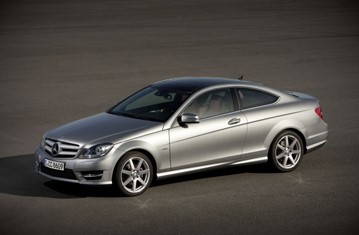

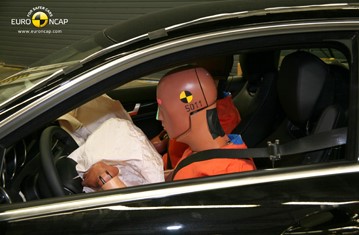
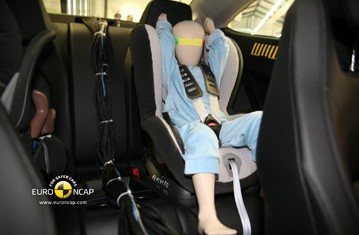
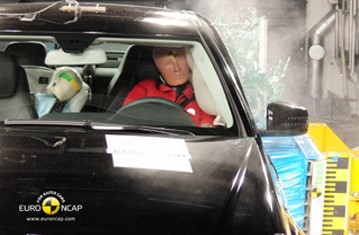
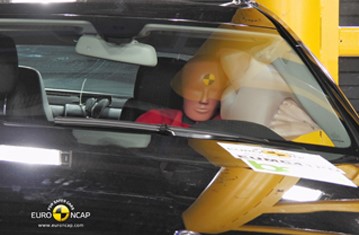
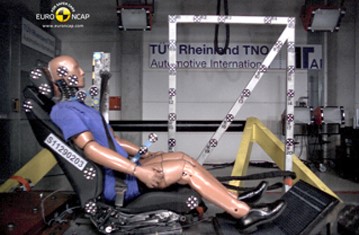
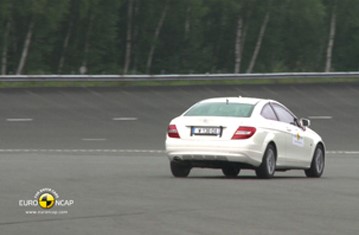




The C-Class Coupe is fitted as option with Mercedes Benz's 'PRE-SAFE®' system which senses when an accident is about to occur and primes the restraint and protection systems in readiness for the collision. In Euro NCAP’s frontal and side barrier impacts, the PRE-SAFE® System was not activated. In the frontal impact, the passenger compartment remained stable. Dummy readings indicated good protection of the knees and femurs of the driver and passenger. Mercedes Benz showed that a similar level of protection would be provided for occupants of different sizes and those sat in different positions. In the side barrier test, the C Class Coupe scored maximum points, providing good protection of all body areas. In the more severe side pole test, protection of the chest was adequate and that of other body regions was good. The C Class Coupe is equipped with an 'active' head restraint. The car automatically detects when it has been struck from behind and the front surface of the head restraint is moved forward, providing earlier support to the occupant's neck. Mercedes Benz showed that the system would work over a broad range of speeds and impact severities. In Euro NCAP's tests the seat and head restraint demonstrated marginal protection against whiplash injuries.